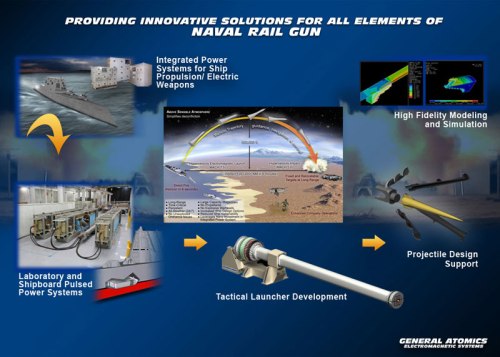Railguns are being researched as weapons with projectiles that do not contain explosives, but are given extremely high velocities: 3,500 m/s (11,500 ft/s, approximately Mach 10 at sea level) or more (for comparison, the M16 rifle has a muzzle speed of 930 m/s, or 3,050 ft/s), which would make their kinetic energy equal or superior to the energy yield of an explosive-filled shell of greater mass. This would allow more ammunition to be carried and eliminate the hazards of carrying explosives in a tank or naval weapons platform. Also, by firing at greater velocities railguns have greater range, less bullet drop and less wind drift, bypassing the inherent cost and physical limitations of conventional firearms–”the limits of gas expansion prohibit launching an unassisted projectile to velocities greater than about 1.5 km/s and ranges of more than 50 miles [80 km] from a practical conventional gun system.”
If it were possible to apply the technology as a rapid-fire automatic weapon, a railgun would have further advantages of increased rate of fire. The feed mechanisms of a conventional firearm must move to accommodate the propellant charge as well as the ammunition round, while a railgun would only need to accommodate the projectile. Furthermore, a railgun would not have to extract a spent cartridge case from the breech, meaning that a fresh round could be cycled almost immediately after the previous round has been shot. Theoretically, successive projectiles could be fired before the previous had even left the rail.
Full-scale models have been built and fired, including a very successful 90 mm bore, 9 MJ kinetic energy gun developed by the US DARPA. Rail and insulator wear problems still need to be solved before railguns can start to replace conventional weapons. Probably the oldest consistently successful system was built by the UK’s Defence Research Agency at Dundrennan Range in Kirkcudbright, Scotland. This system has now been operational for over 10 years at an associated flight range for internal, intermediate, external and terminal ballistics, and achieved several mass and velocity records.
The Yugoslavian MTI (MTI – Military – technology institute) developed, within a project named EDO-0, a rail gun with 7 kJ kinetic energy, in 1985. In 1987 a successor was created, project EDO-1, that used projectile with a mass of 0.7 g and achieved speeds of 3,000 m/s, and with a mass of 1.1 g reached speeds of 2,400 m/s. It used a track length of 0.7 m. According to those working on it, with other modifications it was able to achieve a speed of 4,500 m/s. The aim was to achieve projectile speed of 7,000 m/s. At the time, it was considered a military secret.
The United States military is funding railgun experiments. At the University of Texas at Austin Institute for Advanced Technology, military railguns capable of delivering tungsten armor piercing bullets with kinetic energies of nine megajoules have been developed. 9 MJ is enough energy to deliver 2 kg of projectile at 3 km/s–at that velocity a rod of tungsten or another dense metal could easily penetrate a tank, and potentially pass through it.
The United States Naval Surface Warfare Center Dahlgren Division demonstrated an 8 MJ rail gun firing 3.2 kg projectiles in October 2006 as a prototype of a 64 MJ weapon to be deployed aboard Navy warships. The main problem the Navy has had with implementing a railgun cannon system is that the guns wear out due to the immense heat produced by firing. Such weapons are expected to be powerful enough to do a little more damage than a BGM-109 Tomahawk missile at a fraction of the projectile cost. Since then, BAE Systems has delivered a 32 MJ prototype to the Navy.
On January 31, 2008 the US Navy tested a railgun that fired a shell at 10.64 MJ with a muzzle velocity of 2,520 m/s. Its expected performance is a muzzle velocity over 5,800 m/s, accurate enough to hit a 5 meter target over 200 nautical miles (370.4 km) away while firing at 10 shots per minute. The power was provided by a new 9-megajoule (MJ) prototype capacitor bank using solid-state switches and high-energy-density capacitors delivered in 2007 and an older 32-MJ pulse power system from the US Army’s Green Farm Electric Gun Research and Development Facility developed in the late 1980s that was previously refurbished by General Atomics Electromagnetic Systems (EMS) Division. It is expected to be ready between 2020 to 2025.
The most recent test of a railgun took place on December 10th, 2010, by the US Navy at the Naval Surface Warfare Center Dahlgren Division. During the test, the Office of Naval Research set a world record by conducting a 33 MJ shot from the railgun, which was built by BAE Systems.
